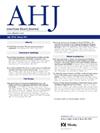Premature Menopause and Risk of Cardiovascular Outcomes: A Propensity-Matched Analysis Using the TriNetX Research Network
IF 3.5
2区 医学
Q1 CARDIAC & CARDIOVASCULAR SYSTEMS
引用次数: 0
Abstract
Background
Premature menopause (PM) affects approximately 1% of women under 40 years of age and may increase cardiovascular risk but specific outcomes remain incompletely characterized. This study aimed to compare mortality and cardiovascular events between women with premature menopause and age-matched controls.
Methods
We performed a retrospective cohort study using the TriNetX Research Network (130 healthcare organizations). Women with PM (ICD-10 codes E28.31, E28.3, E28.319, E28.310) were compared to age-matched controls without PM. After propensity score matching for baseline demographics and comorbidities, cohorts of 9,245 patients each were analyzed. The primary outcome was all-cause mortality. Secondary outcomes included heart failure (HF), arrhythmias, cerebrovascular disease (CVD), and other cardiovascular events. Outcomes were assessed using risk analysis, Kaplan-Meier survival analysis, and number of instances analysis over a 10-year period.
Results
In propensity-matched cohorts, PM was associated with significantly higher all-cause mortality compared to controls (1.8% vs 0.6%; risk ratio [RR] 3.08, 95% CI 2.26-4.19; p<0.001). Women with PM had higher risks of CVD (RR 1.39, 95% CI 1.07-1.82; p=0.014), HF (RR 1.22, 95% CI 0.91-1.63; p=0.192), peripheral arterial disease (PAD; RR 1.43, 95% CI 1.06-1.95; p=0.019), and coronary artery disease (CAD; RR 1.54, 95% CI 1.01-2.34; p=0.044). No statistically significant differences were observed in atrial fibrillation or ventricular tachycardia rates.
Conclusion
PM is associated with significantly higher all-cause mortality and increased risk of CVD, HF, PAD and CAD. These findings highlight the importance of cardiovascular risk assessment and prevention in women with PM.
过早绝经与心血管疾病风险:TriNetX研究网络的倾向匹配分析
背景:40岁以下女性中约有1%的女性过早绝经,并可能增加心血管风险,但具体结果尚未完全确定。这项研究的目的是比较过早绝经妇女和同龄对照组的死亡率和心血管事件。方法采用TriNetX研究网络(130家医疗机构)进行回顾性队列研究。患有PM的女性(ICD-10代码E28.31, E28.3, E28.319, E28.310)与没有PM的年龄匹配的对照组进行比较。在基线人口统计学和合并症的倾向评分匹配后,分析了9245名患者的队列。主要结局为全因死亡率。次要结局包括心力衰竭(HF)、心律失常、脑血管疾病(CVD)和其他心血管事件。使用风险分析、Kaplan-Meier生存分析和10年期间的病例数分析来评估结果。结果在倾向匹配的队列中,与对照组相比,PM与更高的全因死亡率相关(1.8% vs 0.6%;风险比[RR] 3.08, 95% CI 2.26-4.19; p<0.001)。PM女性患心血管疾病(RR 1.39, 95% CI 1.07-1.82; p=0.014)、心绞痛(RR 1.22, 95% CI 0.91-1.63; p=0.192)、外周动脉疾病(PAD; RR 1.43, 95% CI 1.06-1.95; p=0.019)和冠状动脉疾病(CAD; RR 1.54, 95% CI 1.01-2.34; p=0.044)的风险较高。两组在房颤和室性心动过速方面无统计学差异。结论pm与CVD、HF、PAD和CAD的全因死亡率显著升高相关。这些发现强调了PM女性心血管风险评估和预防的重要性。
本文章由计算机程序翻译,如有差异,请以英文原文为准。
求助全文
约1分钟内获得全文
求助全文
来源期刊

American heart journal
医学-心血管系统
CiteScore
8.20
自引率
2.10%
发文量
214
审稿时长
38 days
期刊介绍:
The American Heart Journal will consider for publication suitable articles on topics pertaining to the broad discipline of cardiovascular disease. Our goal is to provide the reader primary investigation, scholarly review, and opinion concerning the practice of cardiovascular medicine. We especially encourage submission of 3 types of reports that are not frequently seen in cardiovascular journals: negative clinical studies, reports on study designs, and studies involving the organization of medical care. The Journal does not accept individual case reports or original articles involving bench laboratory or animal research.
 求助内容:
求助内容: 应助结果提醒方式:
应助结果提醒方式:


